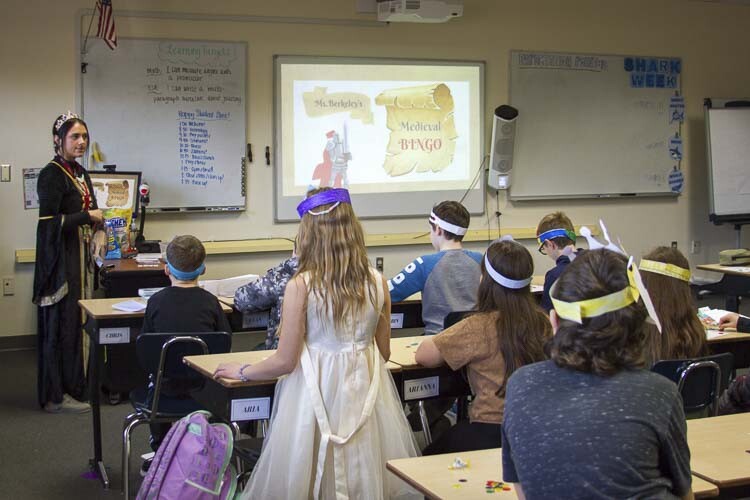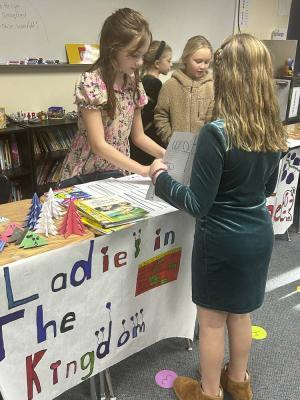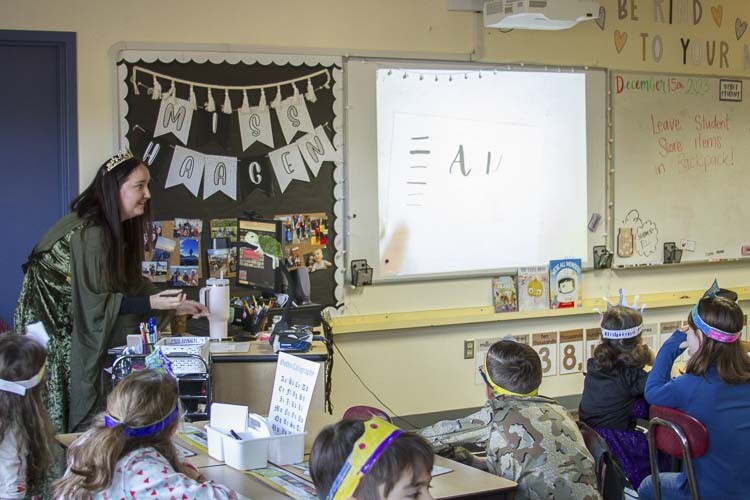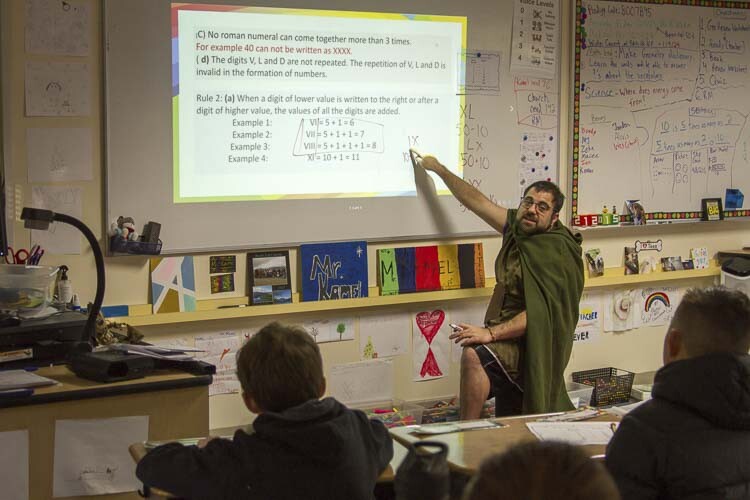
The day was filled with a variety of activities capitalizing on the students’ lessons throughout the unit culminating in a medieval market
Fourth graders at North Fork Elementary School took part in a day-long Medieval Fair capping off their study of the Middle Ages. The day was filled with a variety of activities capitalizing on the students’ lessons throughout the unit culminating in a medieval market where students sold their own homemade arts and crafts for currency earned throughout the unit.

Students also engaged in numerous writing opportunities with a focus on writing fictional narratives, grammar, and morphology. “During our Middle Ages unit, students were asked to engage in rich conversations about the world around them and build their background knowledge to comprehend a variety of complex texts,” said Matthew Kamel, a fourth-grade teacher at North Fork. “As a whole, students critically analyzed what life was like in the Middle Ages, then compared and contrasted different roles of the feudal system.”
The teaching team also expanded on the lesson plan with more elaborate projects and lessons. “As a team, we followed the lesson structure, but also wanted to bring the Middle Ages to life, so we also used videos correlated to the lesson; presented opportunities for students to provide feedback and discuss what they learned; and students also analyzed the differing architecture between castles made of motte-and-bailey and those constructed from stone,” said Kamel. “Additionally, students made stained glass art, practiced calligraphy, and created their own coat of arms, all methods of incorporating activities to help students understand, engage, and bring their learning to life.”

On the day of the fair, each teacher selected an activity that incorporated content taught throughout the unit with students rotating from one activity to the next:
- Kamel enjoys teaching math, so he introduced students to the Roman Numeral system used during the era.
- Kristy Haagen used her expertise in handwriting to demonstrate how writing looked in the Middle Ages to students.
- Jamie Churchman used the arts to help students create silhouette pictures.
- Finally, Antimony Berkeley brought excitement to the stations with medieval bingo using appropriate vocabulary.
The medieval market spawned from an existing student store concept. “Our student store has always been a fourth-grade tradition,” explained Kamel. “As long as we use this curriculum, we will plan to turn our student store idea into a learning experience by having an annual Medieval Fair.” However, organizing and planning the Medieval Fair required the teachers to collaborate and intentionally use the weeks leading to winter vacation to prepare students for the event. “We also realized creating the decorations used during the fair would be too time-consuming for just us to do,” said Kamel. “So, we reached out to parents and were lucky to have a team volunteer to help transform the hallway with banners and other decorations.”

Some of the more popular lessons from the unit included learning about the different social classes that existed during the Middle Ages. “The way they made connections to their own lives was fascinating to hear,” said Kamel. Students also enjoyed learning about the Black Plague and were able to relate this tragic time in history to similar events they faced during the COVID-19 pandemic. “Learning is all about making connections,” said Kamel. “Studies show that students learn content knowledge more comprehensively when those lessons incorporate interactive learning.”
Learn more about how Woodland Public Schools educates students and serves the community by visiting the dedicated news webpage at www.woodlandschools.org/news/wsd
Information provided by Woodland School District.
Also read:
- Opinion: OIC tells consumers not to pay for ‘insurance’ you won’t likely benefit from: Does that include WA Cares?Elizabeth New (Hovde) of the Washington Policy Center believes you should consider yourself warned by the Office of the Insurance Commissioner about WA Cares and its maybe-only benefit.
- Opinion: Same road, different speed limit?Target Zero Manager Doug Dahl addresses a question about speed limit signs going into and leaving town.
- Progress being made at GRO Parade of Homes siteThe 2024 GRO Parade of Homes, presented by the Building Industry Association of Clark County, is a little more than a month away, and builders are busy completing the luxury homes before the big event, scheduled for Sept. 6 through 22 in Felida.
- Has trust in the media tanked over coverage of President Biden’s decline?After President Joe Biden’s calamitous debate performance against former President Donald Trump, and days after Biden’s decision Sunday not to seek reelection, there are still many questions about how the news media covered Biden’s mental and physical decline.
- Opinion: Hiding the growing cost of the Interstate Bridge replacementJoe Cortright of the City Observatory addresses the rising cost of the Interstate 5 Bridge replacement project.
- Letter: ‘This election I am NOT voting for Greg Cheney’Clark County resident Wynn Grcich shares her thoughts on Rep. Greg Cheney and the issue of fluoridation in area drinking water.
- Major gas line leak closes major arterial in Clark CountyFirefighters from Clark County Fire District 6 responded Thursday (July 25) afternoon to the scene of a major natural gas leak on NE 99th Street, directly in front of Columbia River High School.











